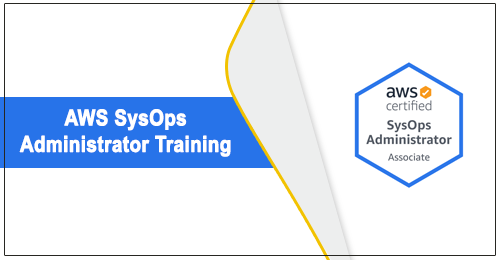AWS SysOps Administrator Certification Training

Goal : In this module, you will you will learn compute services offered by AWS. We will cover different Amazon AMIs, a demo on launching an AWS EC2 instance, connect with an instance and hosting a website on AWS EC2 instance.
Objectives : At the end of this module, you should be able to: Understand Cloud Computing, Understand AWS Availability Zones and Regions.
Topics : Cloud Computing, Cloud Services, Amazon Web Services (AWS), AWS Global Infrastructure.
Hands on : Signing Up for a Free Tier Account with AWS.
Goal : In this module, you will you will learn compute services offered by AWS. We will cover different Amazon AMIs, a demo on launching an AWS EC2 instance, connect with an instance and hosting a website on AWS EC2 instance.
Objectives : At the end of this module, you should be able to: Understand Amazon Machine Image(AMI), Create, Manage and Troubleshoot an Instance, Understand Security Groups, Key Pairs, Tenancy – Shared vs Dedicated, IAM, CLI, Differentiate between Elastic IP & Public IP, Define Elastic Network Interfaces(ENI).
Topics : Introduction, Amazon Machine Image(AMI), What is an Instance?, Types of Instances, Creating Instances, Managing Instances, Troubleshooting Instances, Network Interfaces, Different Categories of IP.
Hands on : Creating EC2 Instance.
Goal : In this module, you will learn about the different storage services offered by AWS and how they can be used to transfer the data.
Objectives : Define Cloud Storage, Define Types of AWS Storage, Create, Manage and Expand Amazon Elastic Block Storage(EBS), Configure Access to Amazon S3 resources, Store and retrieve Amazon S3 objects, Use Amazon Glacier.
Topics : Cloud Storage, Types of AWS Cloud Storage, Understanding AWS Storage, Amazon Elastic Block Storage(EBS), Amazon S3, Amazon Glacier, Storage Security, Storage Gateway, Snowball, Troubleshooting Storage in AWS, Pricing in AWS.
Hands on : Restoring an EBS Volume from a Snapshot, Upload and download files from Amazon S3.
Goal : In this module, you will be introduced to Virtual Private Cloud(VPC), learn about the VPC Scenarios, VPC components, VPC Peering, Configuring Subnets, Network Address Translation(NAT) and Configuring AWS EC2 instance as NAT server.
Objectives : At the end of this module, you should be able to: Understand Cloud Networking, Understand and Configure VPC, Create and Manage Networks in AWS, Configure Route Tables for NAT, Configure EC2 instance as NAT server, Manage Network Security, Troubleshoot Networks.
Topics : Amazon VPC, VPC Subnets, Route Tables, Elastic IPs, Internet Gateway, NAT Gateway, Access Control Lists(ACLs), Security Groups, Creating and Managing a VPC, Route53, Network Security, Troubleshooting Networks in AWS.
Hands on : Building a VPC Environment.
Goal : In this module, you will learn about the different database services offered by AWS to deal with structured and unstructured data.
Objectives : At the end of this module, you should be able to: Understand Different Databases services - Amazon RDS, Amazon DynamoDB, Amazon ElastiCache.
Topics : Types of Database Instances, Amazon RDS, Amazon DynamoDB, Amazon ElastiCache.
Hands on : Creating a MySQL DB Instance via Relational Database Service, Creating a table and loading data in Amazon DynamoDB.
Goal : In this module, you will learn 'scaling' and 'load distribution techniques'.
Objectives : At the end of this Module, you should be able to: Understand Common Deployment Scenarios, Redirect Traffic with Elastic Load Balancing(ELB), Scale to Demand with Auto Scaling.
Topics : Scaling in the Cloud, Load Balancer, Elastic Load Balancing(ELB), Auto Scaling.
Hands on : Auto Scaling to scale up the number of servers available for a specific task.
Goal : In this module, you will learn about the monitoring services offered by AWS. Setting up alerts and notifications for AWS resources and AWS usage billing with AWS CloudWatch. Also track user activity and API usage using CloudTrail.
Objectives : At the end of this module, you will be able to: Use CloudWatch, Use CloudTrail, Retrieve Instance log files with CloudWatch.
Topics : Logging Basics, CloudWatch, CloudWatch logs, AWS CloudTrail, Monitoring and Security, IAM, Troubleshooting.
Hands on : Enabling CloudTrail Log Delivery to a S3 Bucket, Configuring CloudWatch Logs agent on an Instance.
Goal : In this module, you will learn techniques in AWS to manage resource consumption and using configuration management tools.
Objectives : Upon completing this module, you will be able to: Identify cost reduction opportunities, Use Tagging, Use AWS Trusted Advisor, Create and use AMIs, Manage Routing & Traffic flow using Route53.
Topics : Identifying Cost Reduction Opportunities in the cloud, Tagging, Monitoring and Expenditure Alerting with Amazon CloudWatch, AWS Trusted Advisor, Creating Amazon Machine Images(AMI), AWS OpsWorks, AWS UserData, AWS CloudFormation, Amazon Elastic BeanStalk.
Hands on : Create a Stack using an AWS CloudFormation Template.





